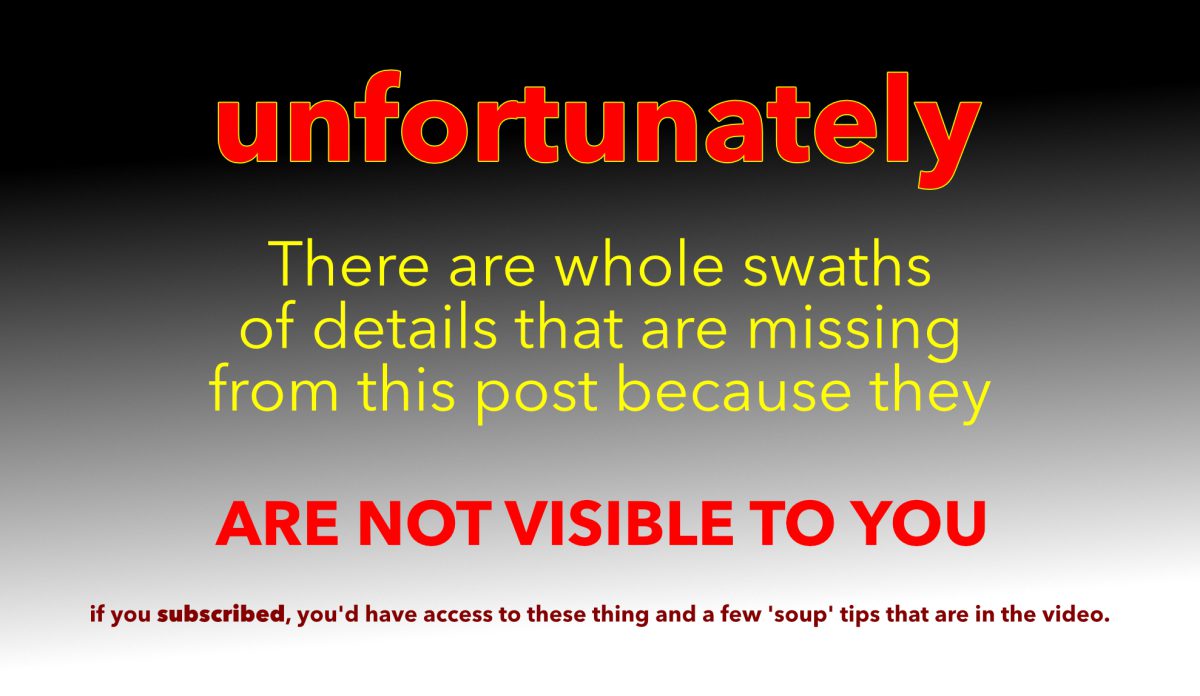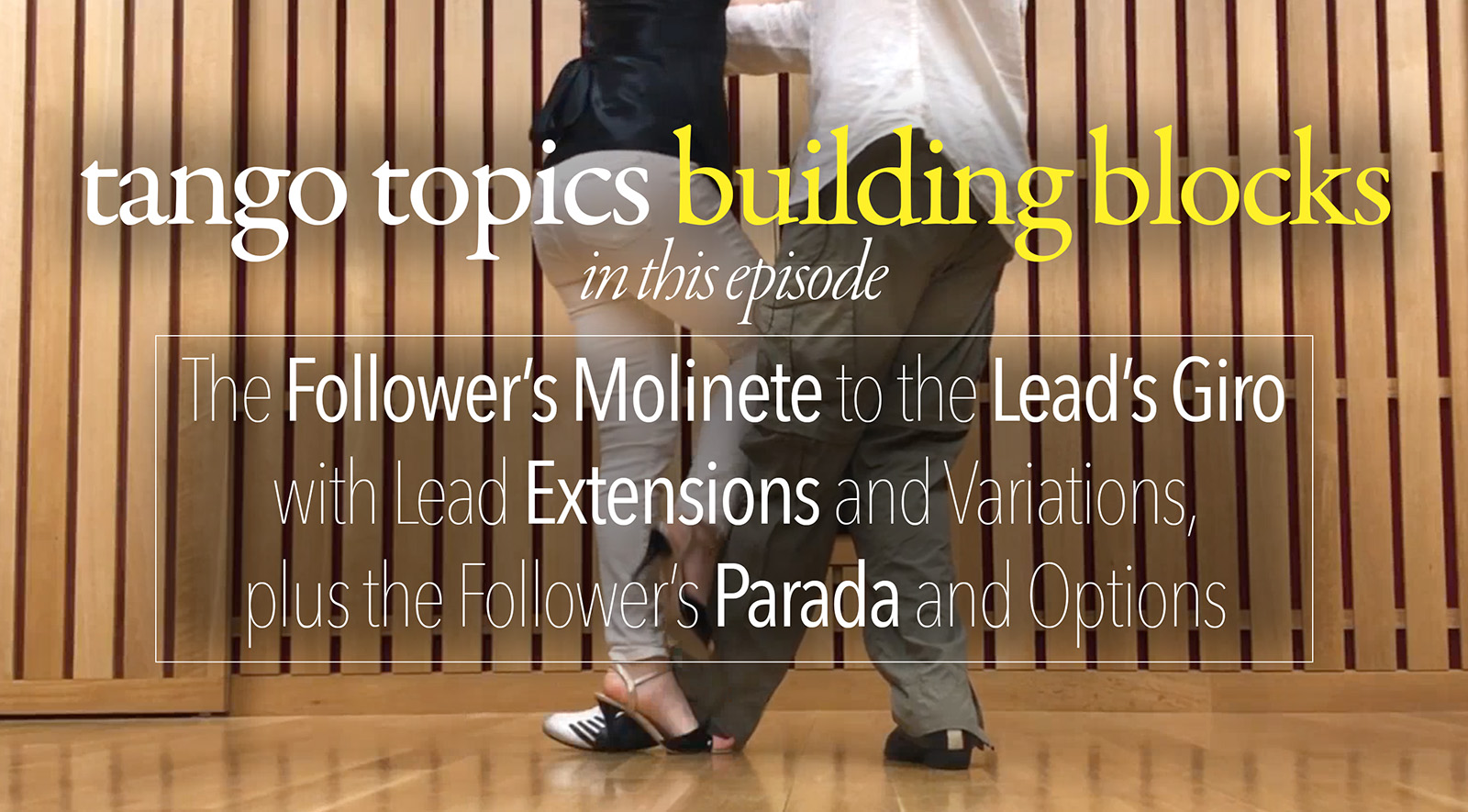In Today’s Building Block Episode (#1) we have three pieces of tango vocabulary that are used frequently in most people’s dance:
1.) The Follower’s Molinete to the Lead’s Giro.
2.) Lead Extensions (sometimes called “projections”), and
3.) The Follower’s Parada with a few variations on a theme. 😉
However, most times we don’t combine them or put them into useful musical expressions. They’re used to get us from point a. to point b. The first of these elements is so ubiquitous that most people don’t even realize they’re employing them. The second gets used with some frequency as an accent idea. And the last one does get used a fair amount and on the scale of execution its difficulty can create a bit of an issue here and there. So it’s a good idea to go look at the foundational and individual technique item for each of the pieces mentioned above to review these items. Today’s Building Block episode discusses these ideas in relation to your dancing experience and creates options and opportunities that you wouldn’t ordinarily think of. The video above is a very, very, very small snippet of what’s present in the Buiding Block.
That said, let’s dive into Today’s Tango Building Block.
What is a Tango Building Block ? In many ways, Tango is a lot like a set of Lego™ Building Blocks. With just a few simple blocks you can build very complex and intricate structures. Tango is the same way. With just a few basic moves like forward, side, and back you can build very complex movements that can later be applied in very different ways. That’s what makes Tango so amazing. It’s never the same dance twice even with the same partner and the same music!
A Tango Topic Building Block goes one step further. This isn’t just about showing you a move or a step, pattern, or figure but giving you tools that you can integrate into your dance immediately. Ideas that you hadn’t even thought of or considered.
Frequently when we dance, we get very ‘stuck’ in our repetition of the same piece of vocabulary over and over and over again. This series is designed to give you ideas, options, and opportunities to employ differences to add a bit of spice to your dance using very simple ideas.
Let’s get something out of the way going further: This video series and everything in that follows is not a step, pattern, or figure video series. We’re not going to teach you a series of patterns. We believe that steps don’t really help you. Tango, for lack of a better way of putting it, is a dance that is choreographed on the fly, meaning that it is improvised. While that improvisation has some elements to it that are common (the building blocks) how you put those elements together is where the real artistry is at. Put another way, the dance is not ‘canned’, meaning that it is mapped out precisely in time to the music as though you would choreograph a ballet. That would be a performance. What Tango Topics is offering you is a way to expand your dancing repertoire using the vocabulary you already know today, in ways you hadn’t really thought of, and more importantly for use on a social dance floor.
A Few Options:
1.) Linear Forward Ochos with Lead Extensions.
2.) A Lead Back Step Parada and a Lead Bolito! (if you were a subscriber, you’d actually see this one here instead of this annoying notice)
3.) Anti Molinete with Lead Extensions!
However without examples, and without the visuals on the page to help you with these ideas then that’s all they’ll ever be — words on the page!

About The Video. This video is 3 sections and when combined create a singular viewing experience of 44m:33s. Part 1 (19:08) – Explains the 3 pieces of vocabulary with options and variations. Part 2 (19:46) is with a Metronome to show you how some of these ideas can be set to a time signature. And part 3 (05:43) is with a piece of music. There is no Technique discussed in the video. For technique please visit the individual topics.
Part 1 – Explanation (00:19:08)
Introduction – 00:00:30
Follower’s Molinete to Lead’s Giro – 00:05:09
Lead Extensions – 00:02:31
Lead Extensions/Lead Bolitos – 00:01:28
Follower’s Parada – 00:03:27
Building Block Ideas
w/Traveling Ochos – 00:01:11
w/Parallel Molinete – 00:01:51
w/Lead Extensions – 00:00:59
w/Lead Bolitos – 00:01:37
Part 2 – Metronome Tools. (00:19:46)
Introduction & Tools – 00:04:54
Traveling Ochos Lead in – 00:05:26
Lead Extensions w/Molinete from Traveling Ochos – 00:01:45
Lead Bolitos w/Molinete from Traveling Ochos – 00:01:28
Follower’s Molinete w/Follower’s Parada – 00:03:19
Argentine Cross w/Follower’s Parada – 00:02:31
Part 3 – Music (00:05:43)

